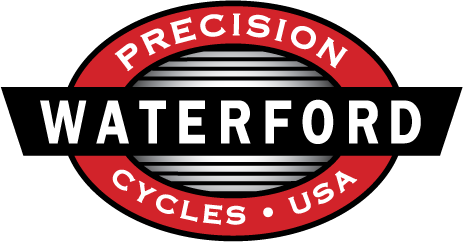FAQ - Frequently Asked Questions
Answer
(See below for more questions.)Troubleshooting
How do I reduce brake squealing?
Brake squealing is annoying to you and fellow riders. Here are a couple of tips, courtesy Jim Langley and Roadbikerider.com:
Check the Rims
Squealing almost always is caused by something that makes the brakes vibrate. Because the wheel rims are the largest component of your braking system, check them first.
Start by ensuring that the wheels are fully inserted, centered and tight in the fork and rear triangle.
To check centering, use your index fingers as feeler gauges by slipping them between the rim and the fork blades and seatstays or chainstays. On a centered wheel, the gap will feel the same on both sides. If it doesn\'t, loosen the wheel and make sure it\'s fully inserted before locking it back down.
Next, spin each wheel. Watch the gap between the rim and a brake pad to see if the rim is true and round. If it wobbles sideways or hops up and down, true the wheel or have a mechanic do it.
Clean the rims if you see brake pad rubber on the sidewalls. Put on rubber gloves, apply a quick-evaporating solvent such as isopropyl alcohol or acetone to a rag, and dissolve the deposits. Avoid getting solvent on the tires.
Also check for a related issue -- rim glazing. This is when the sidewall gets too smooth and shiny in spots. The fix is usually as easy as buffing with a piece of fine emery paper (or a green scrubbie for washing dishes). You want the sidewall to be clean but dull all the way around on both sides.
Check the Calipers
Vibration that causes squealing can come from a brake that\'s loose on the frame or that has loose parts.
Check each caliper by squeezing its brake lever to hold the pads against the rim. This ensures that the brake will stay centered as you put a wrench on the bolt that holds it to the fork crown or seatstay bridge. Turn clockwise to make sure it\'s snug.
Next, face the brake and grip each pad. Push and pull to feel for play in the brake arms. Look for a bolt or nut to tighten on a loose arm. Don\'t overdo it. The brake should open and close crisply when you work the lever.
Tip: Brakes need lubrication to work best. Place a rag over the wheel and pads. Then carefully apply drip or spray lube to the brake pivot points, the tips of the brake springs where they rest on the stops, the quick-release mechanism and the cable adjusting barrel. Wipe off any excess.
Check the Pads
Start by making sure they\'re not worn out. Most brake pads have grooves to indicate wear. When the grooves are gone it\'s time for new pads.
It\'s a good idea to replace pads that are several years old even if grooves remain. Rubber can harden with age and this can cause squealing when everything else checks out.
On most modern brakes, pad replacement is as easy as backing out the tiny keeper screw on the holder, then sliding the old pad out and the new pad in (note its proper direction). Retighten the keeper screw.
Tip: Brake pads come in hard and soft rubbers. Going to a softer compound may be all it takes to silence squealing. Ask your local bike shop for aftermarket pad suggestions. For example, I use KoolStop\'s Dura Type pads as replacements for Shimano Dura-Ace.
Check pad alignment. Look from the side as you squeeze the brake lever. Make sure the pads are parallel to the rim and making full contact -- not above or below the rim sidewall.
Sight from above. As the pads contact the rim, see if their front end touches first. This is called \"toe in\" and it can be the solution to squealing.
Not all brakes need to have toed-in pads. But if your brakes are noisy it\'s worth a try. Some brakes let you set toe-in by rotating the pad on a curved washer (made for this purpose) under the holder.
Be careful. Pad position on these brakes is almost infinitely adjustable so it\'s best not to fully loosen the holder. Slightly loosen its bolt, hold it with pliers, gently adjust the pad position, and then tighten the bolt to lock it in place.
Tip: To set toe-in while the pad holder is loose, wrap an elastic around the brake lever to hold the pads against the rim. Slide a short shim cut from a business card under the tail end of the pad and align the pad to the rim. When it\'s perfect, tighten the bolt and remove the shim. Repeat on the other side.
Now the front of the pads will touch the rim first when you brake - and hopefully the noise goes away.
